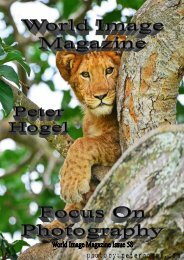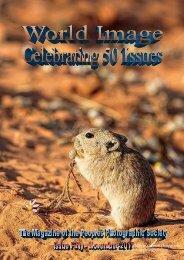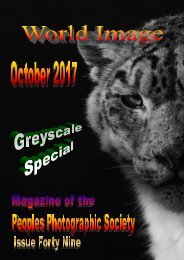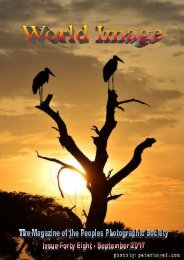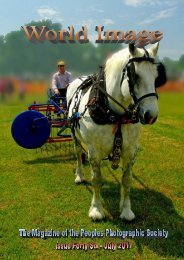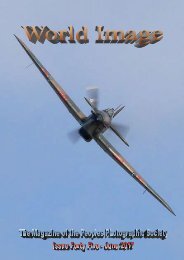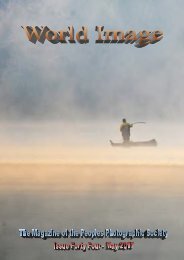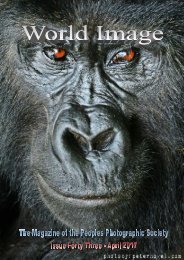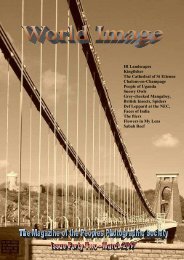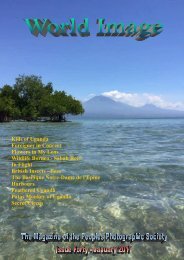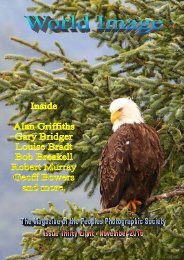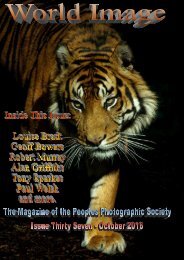World Image Issue 47 August 2017
World Image Issue 47 August 2017. The magazine deals with a variety of subjects but the content depends on those photographers own speciality. The bulk is currently wildlife and nature, but it varies.
World Image Issue 47 August 2017. The magazine deals with a variety of subjects but the content depends on those photographers own speciality. The bulk is currently wildlife and nature, but it varies.
Create successful ePaper yourself
Turn your PDF publications into a flip-book with our unique Google optimized e-Paper software.
Website = photosociety.net Page 1 email = magazine@photosociety.net
National and Regional Management<br />
Gordon Longmead - England - CEO<br />
Peter Hogel - Uganda - Deputy CEO<br />
Scott Hurd - Namibia<br />
Tom Coetzee - South Africa<br />
Paul Welch—Australia<br />
Steve Cook - USA<br />
Robert Murray - Scotland<br />
Tina Andreasson - Sweden and Mexico<br />
Jack Glisson - Kentucky USA<br />
Contents:<br />
4 Looking at Trees - Gordon<br />
6 USA - Massachusetts with Patricia McNamara<br />
10 Sri Lanka with Tony Sparkes<br />
16 A Study in IR - Landscapes With Alan Griffiths<br />
18 Oh To Be a Photographer - Gordon<br />
21 A Study in Nature - Jay Landing - Pictures by Scott Latham<br />
22 India with Subhasish Bhattacharya<br />
24 Sarah McKeenan<br />
25 Uganda with Matthias Mugisha of Pearlescent.<br />
26 Australia, Eden NSW with Geoff Bowers<br />
28 Canadian Sunrise with Kevin W. Moore<br />
30 People of Uganda With Gordon Longmead<br />
34 Turkey Shoot with Patricia McNamara<br />
36 Dangerous Photography Part 1 With Paul Welch<br />
43 Wildlife of America - Ducks by Larry Hitchins<br />
44 Flowers in My Lens - Gordon Longmead<br />
48 Murchison Falls Uganda with Peter Hogel<br />
52 Canada with Bob Breakell<br />
60 British Dreams - Photography by Gordon Longmead<br />
© Please remember that all articles and images published in this magazine are copyright protected<br />
Cover picture - Greater Double-collared Sunbird by Tony Sparkes<br />
Website = photosociety.net Page 2 email = magazine@photosociety.net
Africa and South Africa are adorned with many<br />
species of sunbird sporting many beautiful<br />
colours.<br />
During the winter month's (March-<strong>August</strong>) the<br />
wild aloe's flower in South Africa giving not only<br />
a glorious flush of colour to the country side and<br />
the road side but much needed food (nectar) for<br />
many birds, especially the Sunbirds.<br />
This Greater Double-collared Sunbird (Cinnyris<br />
afer) is no exception. I captured this male during<br />
and early morning photographic session in<br />
Wilderness National Park - Eastern Cape - South<br />
Africa.<br />
Fact: Sunbirds have special 'adaptive' tongues to<br />
retrieve the nectar from various plants..A ploy by<br />
the plants to assist with pollination. If you look<br />
closely at the photograph you can see his long thin<br />
tongue.<br />
Tony Sparkes<br />
I like nothing more than the peace and solitude of empty camps.. Here in South Africa the camps do<br />
become a lot less full in the winter months.. Here we are a few weeks back in Augrabies National Park -<br />
Northern Cape - South Africa, on quite a cold chilly morning. The only other inhabitants were the Vervet<br />
monkeys - Tony Sparkes<br />
Website = photosociety.net Page 3 email = magazine@photosociety.net
With the onset of autumn the trees begin to change,<br />
shedding the leaves to get rid of the poisonous<br />
elements they extract from the atmosphere and<br />
returning them to the earth where they belong as<br />
harmless fertilizers.<br />
It is this process that gives us the stunning colours<br />
that we all love to see at the end of the harvest.<br />
Oddly, the colder the air temperature gets the more<br />
vivid the colours.<br />
The sun being lower in the sky also takes on a<br />
distinctive glow that appears to enhance the picture.<br />
But how often do we really look at the trees?<br />
Today I was taking the picture of the area you see<br />
above and that very thought came to mind. I realised<br />
that although we often photograph trees and<br />
woodlands, we almost always forget about the tree.<br />
This is really sad in many ways, we miss the beauty<br />
of the structure, and yet we miss something else<br />
which is far more important, we miss the history.<br />
Website = photosociety.net Page 4 email = magazine@photosociety.net
As a historian I have come to look at the buildings<br />
and wonder about the histories they might have<br />
witnessed since they were built. Indeed I have<br />
researched and written those histories, some a few<br />
hundred years old others just a few decades.<br />
Yet the tree on the left of the picture above has<br />
probably stood on this village green for in excess of<br />
300 years, others in the area considerably longer. I<br />
wonder what changes they have witnessed.<br />
So today I decided to take a closer look, and I saw<br />
the scars of mans intervention. But I also saw the<br />
majesty of the tree carved into its very skin.<br />
The bark cracked with age becoming home to<br />
insects, its great branches holding the canopy aloft<br />
so that the birds might have shade and protection for<br />
their nests.<br />
In the natural world these great trees are also quite<br />
clever, they know when winter is approaching with<br />
its icy winds and strong gales. They start to change<br />
when the weather is still warm and mild.<br />
We are excused to the thinking that the biggest<br />
threat to these magnificent structures are the<br />
powerful winds that rage across the planet.<br />
In fact the greatest threat to their survival is<br />
humanity. The mighty oak forests of Britain were<br />
destroyed to provide wood for ships so that ancient<br />
mariners could explore the world and dominate the<br />
seas.<br />
Smaller trees are cut and burned for fuel. Some<br />
forests are set alight because ignorant people do not<br />
know how to use fire, or perhaps they do and use it<br />
to destroy the woodlands for fun.<br />
If we allow the trees to grow and follow their<br />
normal cycle of life, our children would have more<br />
to wonder at.<br />
What ever happened to the balmy days sitting under<br />
such trees with a good book and a picnic hamper,<br />
doing nothing more than listening to the wildlife.<br />
Gordon Longmead<br />
Website = photosociety.net Page 5 email = magazine@photosociety.net
Taken on Cape Cod, Surprise! Both the photographer and the deer<br />
are thoroughly surprised to come across each other in the woods.<br />
We stared at each other for a bit, then I started taking photographs.<br />
The deer was comfortable enough to stay around for a little while .<br />
Coming in and building nest<br />
Taken on Cape Co<br />
Osprey looking for dinner.<br />
Website = photosociety.net Page 6 email = magazine@photosociety.net
Cape Cod Canal Sunset<br />
Spring Colour at Mashpee River Woodlands<br />
Website = photosociety.net Page 7 email = magazine@photosociety.net
The Hawk and The Hummer - amazing with the Hummingbird harassing a Hawk<br />
The Avenue of Flags at the National Cemetery in Bourne, MA.<br />
Website = photosociety.net Page 8 email = magazine@photosociety.net
Catbird playing hide and seek with me in the Bayberry Bush.<br />
Red-bellied Woodpecker having a tasty treat<br />
from the Tea Pot.<br />
Website = photosociety.net Page 9 email = magazine@photosociety.net
Glenda and I spent the 10 days at The Coconut Garden<br />
Hotel and Restaurant -Tissamaharama - Sri Lanka. We<br />
spent 5 awesome nights there and used it as a<br />
'photographic base' for access to the local game reserves<br />
and the great Tissa Lake.<br />
Just to give you a taste of what can be experienced there<br />
for those who haven't been, these are samples of the<br />
sunsets.<br />
I was photographing birds at Tissa Lake at the bottom of<br />
our hotel this gave me a great location to swop out the<br />
lens and get up close and personal for this sunset pic.<br />
Below, another take on my last sunset, as I said at the<br />
time I was photographing birds at Tissa Lake at the<br />
bottom of our hotel, another close up of the same sunset,<br />
a little later into the evening just before dropping below<br />
the horizon .<br />
Website = photosociety.net Page 10 email = magazine@photosociety.net
A pair of Green Imperial Pigeons (Ducula<br />
aenea) sat on top tree's in the early morning<br />
light of the gardens of the hotel -<br />
Tissamaharama - Sri Lanka.<br />
Staying with the theme of 'pairs', this pair<br />
are Oriental Darters (Anhinga<br />
melanogaster) bathing in afternoon sunshine<br />
on the great Tissa Lake just below the hotel<br />
-Tissamaharama - Sri Lanka.<br />
A Tufted Gray Langur (Semnopithecus priam) mother<br />
and her infant clinging to her for security.<br />
One of 2 primate species I encountered in Sri Lanka's<br />
Bundala National Park on a recent trip. I felt the high<br />
contrast monochrome image gave good detail to the<br />
Langurs fur for this shot.<br />
Website = photosociety.net Page 11 email = magazine@photosociety.net
A cell phone 'pano' shot of 'Yala' Beach in Sri Lanka.. Just playing around with some<br />
Sri Lanka has 4 Bee-eater species, 2 winter migrant<br />
species and 2 resident species. Here is the Green<br />
Bee-eater (Merops orientalis) a common breeding<br />
resident. I just love the many colours of the worlds<br />
Bee-eater populations and the Green-bee Eater is This is the Blue-tailed Bee-eater (Merops philippinus)<br />
no exception.<br />
a common winter migrant.<br />
Website = photosociety.net Page 12 email = magazine@photosociety.net
Yellowed, Grain, etc.. added - Tony Sparkes<br />
It was a long, long way away but this was my first sighting of a Sri Lankan Leopard (Panthera pardus kotiya)<br />
a sub-species of the Leopard species (Panthera pardus) for instance the Africa sub species are named<br />
(Panthera pardus pardus)<br />
Website = photosociety.net Page 13 email = magazine@photosociety.net
On my recent Sri Lanka trip, one of my target bird species was the Pheasant-tailed Jacana<br />
(Hydrophasianus chirurgus). Although I saw a few, alas no real close ups, this shot was some<br />
considerable distance away. However, I am glad I could tick off this great looking bird.. What a<br />
tail !!!!!!<br />
Tissa Lake in Sri Lanka proved to be a magnet for<br />
birds. One late afternoon Glenda and I took a trip on a<br />
small boat out on to the lake to see what could be<br />
found. The light was soft , although its was a little<br />
windy.<br />
This Indian Pond Heron (Ardeola grayii) was happily<br />
balanced on the giant leaves of the water lilies as we<br />
cruised by.<br />
When exiting Yala National Park, we came<br />
across this beautiful Crested Hawk Eagle<br />
(Nisaetus cirrhatu) drinking in a small dam.<br />
Its one of Sri Lanka's largest at 72cm and is<br />
a breeding resident bird..<br />
Website = photosociety.net Page 14 email = magazine@photosociety.net
During our stay in Sri Lanka, Glenda and I had a chance to photograph wild peacocks. Hailing<br />
from the UK and living in South Africa it was somewhat unusual to find such beautiful birds in the<br />
wild and presenting such great photographic opportunities.<br />
Here I have captured the male Peacock (Pavo cristatus) in some nice soft early morning light in<br />
Lunugamvehera National Park - Sri Lanka<br />
Sticking with my theme of the Peacock (male) or Indian Peafowl (Pavo cristatus) as it should be<br />
known, this male gave me a little display of those beautiful feathers as the Peahen (female) walked<br />
by.<br />
Just a little different composition to see if it works for this particular shot, constructive critique<br />
welcome on the composition considering I have a full display of feathers I could have chosen.<br />
Website = photosociety.net Page 15 email = magazine@photosociety.net
Website = photosociety.net Page 16 email = magazine@photosociety.net
Website = photosociety.net Page 17 email = magazine@photosociety.net
So it would appear that people are more interested in creating yet more photographic sites on FB than using<br />
the ones we have for the dedicated purpose of teaching and learning. That is of course their right and good<br />
luck to them. But now, here are a few statements that will surprise all of you, well most of you,-<br />
You can not learn to take a good photograph.<br />
You can copy new techniques from others that may change the way you take a picture. But to take a good<br />
photograph you must first teach yourself how to SEE a good picture. The good in a picture is what you see<br />
in it.<br />
The camera will not take a good picture for you.<br />
The camera is a tool, and like all tools you must first learn how to use it correctly. You can be shown how to<br />
use it, but unless the person showing you has the exact same camera, and is an expert at using it, they can<br />
not show you how to use it correctly. Theirs will be different in some way, and no one ever reads the<br />
manual.<br />
No one can teach you to take a good picture<br />
When someone 'teaches' you to take a good picture, what they are really doing is teaching you how to take<br />
their take on good picture. Everyone sees a picture differently. What you may think of as being a<br />
masterpiece, others may consign to the trash bin, but do not be offended, people pay millions for a Van<br />
Gogh and I would not give them house room.<br />
So you want to learn to take a good photograph?<br />
Then get off the couch, buy the best camera you can afford and the best lens you can afford and use it. Take<br />
pictures, hundreds of them of any and every subject.<br />
At the end of year one, select the best 30 - 50 from the year and archive the rest.<br />
At the end of year two select the best 30 - 50 from the year and archive the rest. Compare these to the ones<br />
kept from year one, retain the best 30 - 50 and archive the rest. (I will hazard a guess that all of those from<br />
year one will be archived).<br />
At the end of year three select the best 30 - 50 from the year and archive the rest. Compare these to the ones<br />
kept from year two, retain the best 30 - 50 and archive the rest. (I will hazard a guess that most of those<br />
from year two will be archived).<br />
In year three or year four something will happen to you, you will be walking or driving along and instead of<br />
saying what a lovely view you will catch yourself saying what a lovely picture. Quite simply the world<br />
around you will become somehow different, you will see pictures where previously there were none, you<br />
will see the colours for the first time, you will see objects that will spoil the picture that you never noticed<br />
before.<br />
That is the moment that you become a PHOTOGRAPHER, not to be confused with a professional<br />
photographer, that is a whole new ballgame.<br />
Finally, do not keep changing your camera just because a new model comes on the market. It costs you<br />
money and will not give you anything you cant get by experience. Some brilliant images are from camera<br />
phones (see those by Alan Griffiths), and loads of crap comes from the most expensive Leica on the market.<br />
Remember, the best photographers in the world will only ever show you their best pictures, not the 30,000<br />
they have taken and discarded to get it.<br />
Website = photosociety.net Page 18 email = magazine@photosociety.net
Up on the moors, and taken and edited with my phone<br />
Alan Griffiths<br />
Something that is easily missed and is probably the most important<br />
thing you will ever be told, and probably ignore, is KNOW YOUR<br />
SUBJECT. If you do not know how the subject behaves or changes<br />
with the light, how do you expect to be in the best place to get the<br />
picture, let alone a good picture.<br />
Additional:<br />
As for taking good photographs, you do have to be able to see the<br />
shot, that's for sure, you also have to know when the right time of<br />
day is to really make that shot come alive and if you are like Alan<br />
and I, you see that shot in black and white or infrared as well, you<br />
don't just see the glorious Technicolor. You see the time of day and<br />
how the clouds and shadows are dancing.<br />
2nd stop off and another phone shot.<br />
Alan Griffiths<br />
Once you see all of this you can capture it with your phone, with an a base model Canon or Nikon with a<br />
little point and shoot or with a Leica M9, as long as you understand and know how to make that camera<br />
sing for you. Because if you don't know how to operate your camera properly you are just a spectator!<br />
Yes you can fix things in post, but there is only so much you can do unless you go down the composite route<br />
and then it suddenly isn't the picture you saw anymore anyway!<br />
Louise Bradt<br />
The Professional Photographer<br />
Many of those who buy a ‘quality’ camera make a number of assumptions:-<br />
I have a top of the range camera therefore I am a photographer …. Wrong<br />
I have a better camera than the next person therefore I take better pictures than them …. Wrong<br />
I have a top of the range camera and have photographed a wedding therefore I am a professional …. Wrong<br />
There are others, but these three are the main ones I hear most.<br />
To be a Professional Photographer you need to have certain attributes, skills and income.<br />
Attributes:<br />
First and foremost you need to have accomplished everything mentioned thus far.<br />
Patience, Patience and more Patience.<br />
And Infinite Luck<br />
Website = photosociety.net Page 19 email = magazine@photosociety.net
Skills:<br />
You need to be an exceptional photographer, not just in the view of your family or in your own eyes.<br />
You need to have the knowledge of lighting and how changes in natural light will effect your subject.<br />
You need to know what to do if your equipment fails.<br />
You need to have people skills.<br />
The list could go on and on but these I consider the most important.<br />
Income.<br />
This is the one that will catch everyone out, except the Professional. You need to make your living from<br />
your camera.<br />
No, you can’t have a day job to pay the bills and call yourself a Professional Photographer. At best you<br />
might be a Semi-Pro, but a professional works at photography full time, often in a studio or on set. The bulk<br />
of their income is from the work they do with the camera.<br />
When you become a professional, you make sacrifices, you start to go without, it is no longer a hobby<br />
because the pictures you take must make you money. Your partner becomes a camera widow, and you start<br />
to take on responsibility.<br />
If you photograph a wedding, you only get one chance, that is your responsibility and your reputation. One<br />
mistake and you must face the first and will damage the second.<br />
G.<br />
I don't often try and get milky way shots, but last night was an opportunity too good to miss. Even with<br />
the light pollution from the neighbours and the tree closest to me which is right by the deck I was<br />
shooting from, it was still amazing. Picture by Louise Bradt<br />
Website = photosociety.net Page 20 email = magazine@photosociety.net
A Study in Nature - Jay Landing<br />
Pictures by Scott Latham<br />
Website = photosociety.net Page 21 email = magazine@photosociety.net
Found the man roaming here and there and<br />
muttering on the narrow lane connecting<br />
the beach and the main road in Bakhkhali.<br />
As soon as he noticed that I wanted to click<br />
his photo he stopped and started posing.<br />
Bakhkhali, West Bengal, India<br />
Don't be late.... Please get your umbrella<br />
repaired ,|Kolkata, India - June <strong>2017</strong><br />
Website = photosociety.net Page 22 email = magazine@photosociety.net
Two way to use the hand pulled rickshaw<br />
Website = photosociety.net Page 23 email = magazine@photosociety.net
A gruesome end for poor frog<br />
A black shouldered kite<br />
Website = photosociety.net Page 24 email = magazine@photosociety.net
THE LUCKY TWO!<br />
My attention was on the rat (edible<br />
in some parts of Uganda) that was<br />
enjoying it's dinner along a<br />
walkway at the Rain Forest Lodge<br />
in Mabira. I was suprised to find<br />
that a Genet cat was trailing the rat<br />
most probably to have it for dinner<br />
as well. I had not seen the genet cat<br />
when I was taking the picture<br />
because it was dark. Now you can<br />
tell the lucky ones that night.<br />
By way of an initial introduction, at<br />
Pearlescent we do photography/film<br />
documentaries in nature and<br />
development work. We sell nature/<br />
art photography wall decor and also<br />
take up photography and filming<br />
assignments in East Africa.<br />
Left: Contagious lion yawn UWEC<br />
Uganda.<br />
Website = photosociety.net Page 25 email = magazine@photosociety.net
Website = photosociety.net Page 26 email = magazine@photosociety.net
Website = photosociety.net Page 27 email = magazine@photosociety.net
WN Church Sunrise was taken at an old church just northwest<br />
of London, Ontario, Canada.<br />
Everyone, even you non-morning folks, lo<br />
early one <strong>August</strong> morning so I went for a d<br />
noticed a light mist hanging over Stoco La<br />
open spot, grabbed my camera and set up in<br />
some shots. This was one my favourites.<br />
Where ever you live in our world the<br />
wonder of nature. It forms the beginning<br />
and sea. Ancient man worshiped its comi<br />
These are the reasons that the sunrise is<br />
to our world we wonder at the beauty of<br />
is equal beauty at the beginning of the<br />
asleep.<br />
Perhaps it is time to wake up in the da<br />
wonder at the beauty that starts the day.<br />
G.<br />
Sunrise through the Cedars was taken early one January<br />
morning near Strathroy, Ontario, Canada.<br />
Website = photosociety.net Page 28 email = magazine@photosociety.net
TB Sunrise was taken on a VERY cold February morning during<br />
Canadian winter near Strathroy, Ontario, Canada. If I remember<br />
correctly, the morning, sunrise temp was approximately -28C/-26F. Ice<br />
crystals, referred to as Hoare frost, forms on the branches, and anything<br />
else around, usually long before sunrise, giving everything a beautiful<br />
Sunrise, May 4th was taken by a farm near Strathroy, Ontario,<br />
Canada.<br />
Website = photosociety.net Page 29 email = magazine@photosociety.net
Website = photosociety.net Page 30 email = magazine@photosociety.net
Website = photosociety.net Page 31 email = magazine@photosociety.net
Website = photosociety.net Page 32 email = magazine@photosociety.net
Website = photosociety.net Page 33 email = magazine@photosociety.net
Website = photosociety.net Page 34 email = magazine@photosociety.net
Website = photosociety.net Page 35 email = magazine@photosociety.net
In all my years as a photographer/ TV<br />
cameraman combined, which is more than I<br />
would like to say. I have been in situations<br />
that many people would say I was mad to do.<br />
I find that putting yourself in a certain<br />
amount of danger can create great results and<br />
have a great story to tell with plenty of<br />
adventure. I’m not saying to run out and do<br />
something stupid, but being sure to get the<br />
story right from what you had seen.<br />
To create a story with a Photograph is what<br />
we artists love to try and do, but… Yes BUT,<br />
there is a down side. We put ourselves in<br />
harm’s way on occasions to do so.<br />
I have on many occasions said, “If it’s my<br />
time to go nothing will stop it happening”.<br />
Do we really have to put ourselves in danger,<br />
or is it an adrenaline junky thing?<br />
I have put myself in positions facing danger<br />
in so many ways from being on a boat in 4-5<br />
meter swells filming fishing shows,<br />
To hanging from cliff edges for that right<br />
position to get a shot of what I want the<br />
viewer to see through what I see at that<br />
moment.<br />
Getting the shot to look the way you see it is<br />
still tricky.<br />
Take for example a drop from a cliff edge. I<br />
was hoping a shot I took looked scary, but<br />
when I got back to the computer and looked<br />
at it, I just didn’t get the same feeling as<br />
what I felt when I took the shot.<br />
I had half my body hanging over a ledge in<br />
the gorges of Karijini looking straight down<br />
the face of the cliff with about a 100+ meter<br />
drop.<br />
While I was taking the shot I didn’t think<br />
much about it until the other camera man<br />
said it was a scary thought, that at any given<br />
moment those rocks could have crumbled<br />
and I would have found myself sailing down<br />
to the pool at the bottom… That’s if I didn’t<br />
hit anything else on the way down.<br />
It was pretty disheartening to see the shot<br />
knowing what I did to get it, yet to me; it just<br />
didn’t tell the story I wanted. Maybe it was<br />
just me.<br />
I figure the trick is to actually feel the fear<br />
you need to get the shot, but when I’m in the<br />
zone of getting a shot I want, I really don’t<br />
think about fear of what might or could<br />
happen.<br />
Website = photosociety.net Page 36 email = magazine@photosociety.net
Being safe is the number one thing on the list<br />
in photography, especially when it comes to<br />
facing dangerous creatures.<br />
Living in Australia is already a dangerous<br />
game IF you don’t have the knowledge<br />
about what is out there.<br />
That’s where Photography can be<br />
dangerous… If you’re stupid!!<br />
This spot just had so many features I wanted<br />
to capture but didn’t have the time, to take<br />
my time due to filming.<br />
Another shot I took in the same area after<br />
filming was something I was quite proud of.<br />
This shot I was hanging off a cliff edge by<br />
my fingertips to get it. I was pleased that it<br />
turned out exactly how I wanted it to.<br />
Being in the face of danger can be taken in a<br />
literal way here as well as other parts of the<br />
world like Africa or Indonesia to name a<br />
couple. But knowledge as they say is power.<br />
I have photographed scenery on a lot of<br />
occasions where I have been waist deep in a<br />
fast flowing river or on a cliff edge<br />
overlooking raging seas, but nothing<br />
compares to photographing some of the<br />
wildlife that you can come across on a daily<br />
basis in these countries, and if you don’t<br />
respect them or know enough about them<br />
you could put yourself in harm’s way that<br />
will hurt if not kill you.<br />
Let’s start with getting to know your<br />
subjects.<br />
The second cameraman that was on the other<br />
side of the gorge filmed me with my DLSR<br />
camera over one shoulder, a large tripod and<br />
video camera over the other shoulder<br />
heading straight for the edge of the cliff. As<br />
seen in the previous picture.<br />
I don’t really have any death wishes but I<br />
really enjoy the fact of getting shots others<br />
are less likely to get due to fear. I’m sure<br />
many of you have had moments where<br />
something could have gone terribly wrong,<br />
and that’s where the safety factor comes in.<br />
I have lived in Australia for about 23 years<br />
now and I have gone through the first five<br />
years studying and getting to know the<br />
wildlife that resides all around us and how to<br />
make sure you don’t get in harm’s way while<br />
photographing them… yes that’s right FIVE<br />
years of study.<br />
When I moved here from the UK I already<br />
had a fascination for the wildlife of many<br />
countries but I learned all I could about the<br />
country I moved to for the reason of<br />
Photography… and maybe collecting a few<br />
bugs along the way.<br />
Website = photosociety.net Page 37 email = magazine@photosociety.net
People from other countries have a vivid<br />
imagination of spiders here being massive<br />
and scorpions that live in your shoes so you<br />
check them each time you want to put them<br />
on. Haha, that is far from the truth. I will let<br />
you in on a little secret… Australia isn’t as<br />
dangerous as people think.<br />
We do have many spiders and other<br />
creatures that can kill you but a majority of<br />
the time they will never be seen and you<br />
have to go looking for them to photograph<br />
them.<br />
I have looked for and found many of the so<br />
called dangerous spiders and out of the<br />
many only two spiders give me the heebee<br />
jeebee’s. No, not the redback that everyone<br />
fears so much and is portrayed as a huge<br />
spider when the female is the larger of the<br />
species and only gets to about 2-2.5 cm<br />
long. So photographing them is easy, but<br />
you need a macro lens.<br />
Despite the theory that they are so<br />
dangerous they can kill a person in a short<br />
time, which they can’t!! It’s really a matter<br />
of how sensitive you are to the venom and<br />
even if you are, you still have plenty of time<br />
to get the anti-venom and be better in a<br />
couple of days.<br />
However, the wolf spider is a very different<br />
kettle of fish… well spider.<br />
The males are not so bad, but you still have<br />
to be cautious if you want to get close to<br />
them. The females on the other hand, DO<br />
NOT HANDLE THEM or get too close.<br />
These can be very aggressive spiders and<br />
need the utmost respect for good reason.<br />
They will sink their fangs into you if given<br />
the chance mostly during breeding season.<br />
Despite what any Professional arachnid<br />
fanatic tells you, these spiders can be very<br />
aggressive… I know I was there. Hahaa<br />
The only time they bite is if you are unlucky<br />
enough to get one in some clothing or your<br />
bed… extremely rare.<br />
This shot was taken with a 90mm macro<br />
lens in a very controlled area.<br />
Website = photosociety.net Page 38 email = magazine@photosociety.net
When I say controlled I mean an area it<br />
can’t get out of. As awesome a shot this is,<br />
this spider pic was taken in a tank where it<br />
couldn’t get out, and go the distance and do<br />
the damage it really wanted to do at the<br />
time.<br />
Know your subject well before attempting<br />
to take a picture close up… Once again<br />
Knowledge is power.<br />
This catch and release works well on a lot of<br />
creatures if you know your subjects well<br />
enough and have a good enclosure to<br />
transport them in for Photographing.<br />
Another deadly creature that occurs here<br />
and other places are snakes. Australia has<br />
more deadly snakes than anywhere in the<br />
world. A very common one to come across<br />
is the Dugite.<br />
Photographing snakes, you have to know<br />
about how any reptile works. When a reptile<br />
is cold it is slow and docile but beware as<br />
they can be temperamental.<br />
I have handled snakes here on many<br />
occasions and know how and when you can<br />
get near a snake or large reptile like our<br />
Goannas.<br />
This large dugite was on a local beach on a<br />
cold day it was easy to handle and be able to<br />
have the pleasure of getting so close to<br />
something this dangerous.<br />
My wife and I only had our phones with us<br />
at this time and when we came back<br />
prepared on several occasions. We just<br />
couldn’t find any snakes again.<br />
Website = photosociety.net Page 39 email = magazine@photosociety.net
The Tiger snake is a beautifully coloured<br />
snake that can reach lengths of up to around<br />
2 meters. It is apparently related to the cobra<br />
and when threatened flattens it sides like the<br />
cobra to make it look bigger.<br />
When I first came to Australia, I was told<br />
the tiger snake will go for you rather than<br />
slither away. But now I have learned on<br />
many occasions including when I did my<br />
snake handling certificate that they will only<br />
ever attack people if they are stepped on or<br />
have nowhere to go.<br />
I have seen quite a few tiger snakes now and<br />
each time my wife and I went looking for<br />
them we had to be up before the sunrise.<br />
Even when we did find one, they were very<br />
hard to photograph. They would get a whiff<br />
of you, and then disappear as quickly as<br />
they could.<br />
We had to sneak up really slowly to get this<br />
shot from downwind before he noticed us<br />
getting too close and disappearing into the<br />
long grass to get away.<br />
Apart from the many snakes here in<br />
Australia we have some pretty large lizards<br />
too. I have experienced some of the many<br />
Goannas we have here and I have a very<br />
large advantage to many people on this<br />
particular family of reptile. Photographing<br />
these guys takes a vast amount of patience<br />
in finding them and even more so actually<br />
capturing them close up.<br />
The experience with knowing about these<br />
reptiles’ stems from way back when I was in<br />
the UK I had a pet Monitor called Savage.<br />
We did get lucky with a few shots near one<br />
of the many lakes around Perth.<br />
They love to be around wet and marshy<br />
areas so they hang around close to<br />
waterways.<br />
This is Savage.<br />
This 4.5 foot savanna monitor got me<br />
hanging to face more of these awesome<br />
creatures which have a reputation of being a<br />
dangerous creature. But knowing this<br />
particular family of reptiles has taught me to<br />
be able to see when they will react and how.<br />
This shot was right near a walkway with<br />
people passing by, not even noticing this<br />
big fella (around six foot) wallowing in the<br />
sun rays along the edge of the grass next to<br />
the lake.<br />
The Goanna or as known in other countries,<br />
monitor lizards are part of the aboriginal<br />
culture here in many ways, as well as food<br />
they have a history of dream time stories of<br />
these reptiles portrayed in many aboriginal<br />
art.<br />
Website = photosociety.net Page 40 email = magazine@photosociety.net
One of the aboriginal names for these large<br />
lizards is Bubb-you-bin-marrohoo.<br />
One of the many large goannas I had the<br />
pleasure of facing was a perentie Goanna<br />
Varanus giganteus) it is the largest monitor<br />
lizard or goanna native to Australia, and the<br />
fourth-largest living lizard on earth, after the<br />
Komodo dragon.<br />
These impressive reptiles can grow to a cool<br />
2.5 meters or 8ft 2inches in length. The one<br />
I came across was a mere six to six and a<br />
half foot long. I stopped in a hurry to<br />
capture this beautiful reptile on a dirt track<br />
in the north of Western Australia. A place<br />
called Quobba.<br />
I jumped out of the car to get some shots, as<br />
I jumped out I realized I only had my 18-55<br />
mm lens on the camera. To get the shots I<br />
wanted, I had to get close to it… closer than<br />
most people would dare to get.<br />
Having the knowledge of these reptiles<br />
dating back so long, I could tell he wasn’t<br />
going anywhere and stayed still for me to<br />
get close enough to see the veins in his eyes<br />
Once again it was a cool cloudy day so his<br />
movements were slow. The results speak for<br />
themselves. Even with claws like a bird of<br />
prey, it just didn’t put me off of wanting to<br />
get so close to something that others<br />
wouldn’t even attempt.<br />
Even though this beautiful lizard got a bit<br />
moody, it was a joy to get this close to a<br />
predator of this calibre but nothing quite as<br />
intense as the predators we have in the north<br />
of Australia.<br />
The Salt water Crocodile. Where the<br />
Americans speak about the Alligators being<br />
a creature to be careful with, they are pretty<br />
much like a frog with teeth in comparison to<br />
saltwater crocs we have here in Australia.<br />
Website = photosociety.net Page 41 email = magazine@photosociety.net
Salty’s as we call them here are pretty<br />
creatures when they are young, almost cute;<br />
but when they get to a ripe size of about 5-7<br />
foot… Look out!!<br />
In the category of dangerous creatures to<br />
photograph, these are probably one of the<br />
most dangerous, up there with the<br />
experience of Komodo Dragons… But<br />
that’s a story for another time.<br />
The salt water crocs you can come across<br />
may look big and cumbersome, but mess<br />
with a big one and you will quickly discover<br />
they can move quicker than you would<br />
expect.<br />
They have been found to have the ability to<br />
run up to 29-30 kilometres an hour… so,<br />
just a bit faster than the average man.<br />
Maybe If you were Usain Bolt, you might<br />
stand a chance of putting the croc off of<br />
eating you, but we wouldn’t stand too much<br />
of a chance with one of these slow looking<br />
dinosaurs if they were hungry.<br />
In the aspect of getting close to one of these,<br />
I would definitely suggest getting a nice<br />
long lens of 600mm. and maybe to be sure<br />
you don’t get too close to one of these make<br />
it a 2X adaptor on top of the 600mm…<br />
Just to be safe, you know… so you have<br />
enough distance to get away when it moves<br />
towards you.<br />
Getting close to a salty is a risky thing to do<br />
in the wild; people have been eaten for less<br />
by these monsters.<br />
Well there you have it just a few of the<br />
dangers we have to think about in Australia<br />
while getting THAT shot to start with. I will<br />
carry on with more in the second part of the<br />
creatures you could face and what they are<br />
capable of if you’re not careful.<br />
For those in the more peaceful places for<br />
photography like the UK & some parts of<br />
Europe that don’t face creatures of danger<br />
unless they’re behind glass, enjoy what you<br />
have around you, & if you ever go to a<br />
country with dangerous creatures.<br />
Be very aware of what they can do, be very<br />
safety conscious, be respectful to the<br />
environment they live in… Leave only<br />
footprints behind.<br />
Most of all, don’t take risks without<br />
knowledge of what you are facing… It<br />
could make it your last Photo.<br />
Paul Welch - Australia<br />
Website = photosociety.net Page 42 email = magazine@photosociety.net
Long Tailed Duck<br />
King Eider<br />
Eider<br />
Common Pochard<br />
Hooded Merganser<br />
Silver Woodduck<br />
Website = photosociety.net Page 43 email = magazine@photosociety.net
Website = photosociety.net Page 44 email = magazine@photosociety.net
Website = photosociety.net Page 45 email = magazine@photosociety.net
Website = photosociety.net Page 46 email = magazine@photosociety.net
Website = photosociety.net Page <strong>47</strong> email = magazine@photosociety.net
To me, this is the pearl in the pearl of Africa, the<br />
ever green, lush and diverse Murchison, depending<br />
on the route, about 5 hours from Kampala lays<br />
Murchison, home to so many of Uganda’s wild<br />
animals, once home even to the now extinct white<br />
rhino (we will get back to that one on our trip to the<br />
Ziwa rhino sanctuary).<br />
We go through the northern gates of the park, its<br />
early morning and the sun has just reached above<br />
the horizon, the warm light hits the movement in the<br />
vegetation and already at the gates, elephant<br />
welcome us,<br />
The African Elephant is the largest land animal in<br />
the world easily weighing in at twice the weight of<br />
our safari truck, their sensitive trunks smelling the<br />
air, he knows that we are there, just simply doesn’t<br />
care.<br />
Website = photosociety.net Page 48 email = magazine@photosociety.net
Passing the lonely elephant, heading deeper in to the<br />
park we come across a herd of 15 elephants on their<br />
way to the Nile river for a drink and to cool off.<br />
Murchison is home to the largest population of the<br />
Rothschild’s giraffe with about 1200 left in the wild<br />
some 900 is roaming this park, they are truly huge,<br />
gracious animals.<br />
But don’t be fooled, a side kick from its hoofs can<br />
crush the skull of an attacking lion. We find two<br />
young male giraffes banging their heads against each<br />
other’s necks to establish who is the man… and who<br />
is getting to mate.<br />
Website = photosociety.net Page 49 email = magazine@photosociety.net
Here is the park, where we find lions and leopards<br />
and hyenas, all top of the food chain predators living<br />
of the diversity of antelopes, Kob, warthogs,<br />
buffaloes and even hippos and giraffes.<br />
There is always something going on here, among<br />
topis and hartebeests, hartebeest being known for its<br />
short memory span…running from the car just to<br />
stop after a few meters, looking behind him as if<br />
forgetting what he was running from.<br />
Website = photosociety.net Page 50 email = magazine@photosociety.net
Its coming to afternoon, and we are heading down to<br />
the Nile river, to cruise this longest river in the<br />
world watching the animals by the shore, on our<br />
way up to Murchison falls…stay tuned… Peter<br />
Website = photosociety.net Page 51 email = magazine@photosociety.net
No more mountains or hills for thousands of kilometres.<br />
Website = photosociety.net Page 52 email = magazine@photosociety.net
An orphaned Kodiak bear cub.<br />
Looking out window of our room in Banff Springs Hotel, Banff National Park.<br />
We had a rain shower and then this.<br />
Website = photosociety.net Page 53 email = magazine@photosociety.net
Website = photosociety.net Page 54 email = magazine@photosociety.net<br />
Here in<br />
We have a fe<br />
To go with the B
Website = photosociety.net Page 55 email = magazine@photosociety.net
May 9, 2016 near Bro<br />
Sometimes it pays to be<br />
a camera, at th<br />
Website = photosociety.net Page 56 email = magazine@photosociety.net
Website = photosociety.net Page 57 email = magazine@photosociety.net
House fires can occur anywhere, n<br />
them we stand and watch. We hope<br />
flames. We also watch the fire-figh<br />
the blaze under control, but first and<br />
We have to admire the dedication a<br />
entering a burning building to res<br />
often do we also wonder what<br />
situation?<br />
So imagine someone is inside this b<br />
Look at the three images below, n<br />
which door would you enter by?<br />
Website = photosociety.net Page 58 email = magazine@photosociety.net
-fighters, in<br />
Website = photosociety.net Page 59 email = magazine@photosociety.net
Website = photosociety.net Page 60 email = magazine@photosociety.net
Website = photosociety.net Page 61 email = magazine@photosociety.net
Website = photosociety.net Page 62 email = magazine@photosociety.net
Website = photosociety.net Page 63 email = magazine@photosociety.net
Kuyimba means 'to sing' in the Zambian Chinyanja language<br />
and this site is a celebration of the sights and sounds of<br />
southern Africa. Join us to experience it for yourself.<br />
Derek & Sarah Solomon<br />
www.kuyimba.com<br />
Website = photosociety.net Page 64 email = magazine@photosociety.net
Magazine Submissions<br />
Members are welcome to submit Bio’s and other articles relating to expeditions and equipment<br />
reviews. Small file size pictures may be included. Recognised wildlife trust and Nature<br />
Conservation group adverts may be included free of charge per quarter page subject to approval.<br />
Any one who would like to write a feature article for the magazine, please do. I have no real limit<br />
on the magazine size but for ease I will find a comfortable limit depending on the method used for<br />
circulating it.<br />
Trade Adverts<br />
Adverts may be placed with the magazine at the editors discretion. A charge will be made in<br />
advance of publication towards the running costs of the society amounting to 10 GBP per quarter<br />
page per issue.<br />
Submissions should be emailed to magazine@photosociety.net please state ‘magazine article or<br />
advert’ in the subject line.<br />
Not everything is what it appears at first glance. - GL<br />
The Photographer Academy is the largest European<br />
photography training company providing the award<br />
winning training to get inspired or instructed every day.<br />
http://thephotographeracademy.com<br />
The Cat Survival Trust was registered as a charity in<br />
1976. The Trust's on-site objective is to promote<br />
education regarding the conservation of wild cats and<br />
their habitat by housing an array of species in natural<br />
enclosures.<br />
http://www.catsurvivaltrust.org<br />
We hope you like the magazine, the size and content of future issues depends on you.<br />
Submissions for the next issue are being accepted<br />
Website = photosociety.net Page 65 email = magazine@photosociety.net
Website = photosociety.net Page 66 email = magazine@photosociety.net




